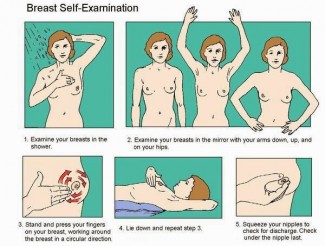
How To Conduct Breast Self-Examination
Until recently discussing breast cancer had been a taboo in our society which was the reason why many women were unaware that they were living with it until it was too late. Studies show that among Asian population Pakistani women have a higher risk of developing breast cancer as compared to any other. 1 in 9 Pakistani women will develop it at some stage in their life. According to American Cancer Society “The chance that breast cancer will be responsible for a woman’s death is about 1 in 36 (about 3%)”. A cancer caught early has the best prognosis and many have been completely cured of it without any future reoccurrences. This only stands to prove the importance of spreading awareness
Breast cancer usually develops in the inner lining of the milk ducts and the tissue around it. A mature human female’s breast comprises of fat, connective tissues and a huge number of lobules – small organs which create milk. The milk of a breastfeeding mother experiences small conduits (tubes) and is conveyed through the areola. The breast, similar to any other organ of the body, comprises of billions of tiny cells. These cells duplicate in a systematic manner – new cells are made to replace the ones that die or are damaged. In cancer, the cells divide rapidly, and produce excessive cells.
The first symptom of breast cancer is thickening around the breast or near the armpit. They usually feel like lumps or masses which may or may not be painful depending on the degree of invasiveness. Doctors recommend that breast examines should be performed every month on the same day. There is a very simple and easy way a breast exam can be performed at home without any assistance. Place a pillow under your right shoulder and your right arm behind your head. Using your left hand, move the tips of your fingers around your right breast in small circular motions over the entire breast and armpit. Use light and firm pressure. Squeeze the nipple; check for discharge and lumps.

Women who detect any of the following signs or symptoms, should inform their doctor:
- A lump in a breast
- A pain in the armpits or breast that does not seem to be related to the woman’s menstrual period
- Pitting or redness of the skin of the breast; like the skin of an orange
- A rash around (or on) one of the nipples
- A swelling (lump) in one of the armpits
- An area of thickened tissue in a breast
- One of the nipples has a discharge; sometimes it may contain blood
- The nipple changes in appearance; it may become sunken or inverted
- The size or the shape of the breast changes
- The nipple-skin or breast-skin may have started to peel, scale or flake.
Although breast cancers are more commonly linked to faulty genes, there are many modifiable risk factors that are not commonly considered when taking precautions. Smoking and a lack of physical exercise have been linked to the prevalence of breast cancer in some cases. A high cholesterol diet, alcohol consumption, obesity and dietary iodine deficiency have been known to play a role. A number of chemicals have also been linked including: polychlorinated biphenyls, hydrocarbons, organic and a number of pesticides. Radiation from mammograms and x-rays are although in very doses, an increased amount of screenings many pose as a risk factor.
October is celebrated worldwide as a breast cancer awareness month. With an increased awareness and development of new and improved ways to treat cancer, we can decrease fatalities amongst women.
Image Source: http://www.lmt-lss.com/

